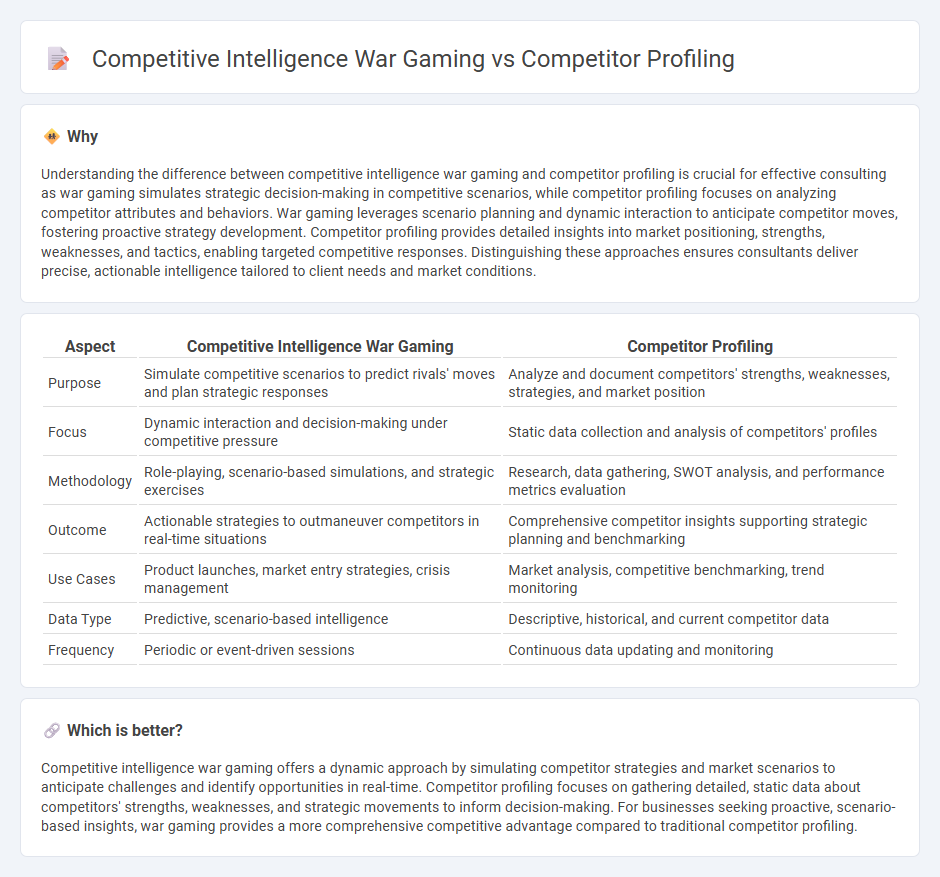
Consulting in competitive intelligence leverages war gaming to simulate competitor moves and market responses, revealing strategic opportunities and threats with high precision. Unlike traditional competitor profiling, war gaming offers dynamic scenario analysis that anticipates competitor behavior and uncovers hidden risks in real-time. Discover how integrating war gaming into your consulting strategy can redefine competitive advantage.
Why it is important
Understanding the difference between competitive intelligence war gaming and competitor profiling is crucial for effective consulting as war gaming simulates strategic decision-making in competitive scenarios, while competitor profiling focuses on analyzing competitor attributes and behaviors. War gaming leverages scenario planning and dynamic interaction to anticipate competitor moves, fostering proactive strategy development. Competitor profiling provides detailed insights into market positioning, strengths, weaknesses, and tactics, enabling targeted competitive responses. Distinguishing these approaches ensures consultants deliver precise, actionable intelligence tailored to client needs and market conditions.
Comparison Table
| Aspect | Competitive Intelligence War Gaming | Competitor Profiling |
|---|---|---|
| Purpose | Simulate competitive scenarios to predict rivals' moves and plan strategic responses | Analyze and document competitors' strengths, weaknesses, strategies, and market position |
| Focus | Dynamic interaction and decision-making under competitive pressure | Static data collection and analysis of competitors' profiles |
| Methodology | Role-playing, scenario-based simulations, and strategic exercises | Research, data gathering, SWOT analysis, and performance metrics evaluation |
| Outcome | Actionable strategies to outmaneuver competitors in real-time situations | Comprehensive competitor insights supporting strategic planning and benchmarking |
| Use Cases | Product launches, market entry strategies, crisis management | Market analysis, competitive benchmarking, trend monitoring |
| Data Type | Predictive, scenario-based intelligence | Descriptive, historical, and current competitor data |
| Frequency | Periodic or event-driven sessions | Continuous data updating and monitoring |
Which is better?
Competitive intelligence war gaming offers a dynamic approach by simulating competitor strategies and market scenarios to anticipate challenges and identify opportunities in real-time. Competitor profiling focuses on gathering detailed, static data about competitors' strengths, weaknesses, and strategic movements to inform decision-making. For businesses seeking proactive, scenario-based insights, war gaming provides a more comprehensive competitive advantage compared to traditional competitor profiling.
Connection
Competitive intelligence war gaming leverages detailed competitor profiling to simulate market scenarios and predict rival strategies, enhancing strategic decision-making. Competitor profiling involves collecting and analyzing data on rivals' strengths, weaknesses, opportunities, and threats, which forms the foundation for realistic war gaming exercises. Together, these tools enable consulting firms to create proactive business strategies that anticipate competitor moves and market shifts effectively.
Key Terms
**Competitor Profiling:**
Competitor profiling involves gathering detailed data on competitors' strengths, weaknesses, strategies, product offerings, and market positioning to anticipate their moves effectively. It emphasizes analyzing financial reports, marketing campaigns, leadership decisions, and innovation efforts to create a comprehensive competitive landscape. Explore more to understand how competitor profiling enhances strategic decision-making and market adaptability.
SWOT Analysis
Competitor profiling relies heavily on SWOT analysis to identify strengths, weaknesses, opportunities, and threats of individual competitors, offering a granular view of their market positioning and strategic capabilities. Competitive intelligence war gaming extends beyond SWOT by simulating competitive scenarios and strategic responses, enabling businesses to anticipate moves and counteractions in a dynamic environment. Explore how integrating SWOT with war gaming enhances strategic decision-making.
Benchmarking
Competitor profiling involves detailed analysis of rivals' strengths, weaknesses, strategies, and market positioning to create accurate benchmarks for performance comparison. Competitive intelligence war gaming simulates strategic scenarios by using competitor data to anticipate moves and outcomes, enhancing decision-making through role-play of competitive dynamics. Explore deeper insights into benchmarking techniques within these approaches to sharpen market strategy and gain competitive advantages.
Source and External Links
Competitor Analysis and Benchmarking Services - Competitor profiling involves a detailed analysis of competitors' strategies, operations, market behavior, strengths, weaknesses, and opportunities to gain strategic advantages, covering aspects such as future plans, market positioning, leadership, financial health, and product development.
How to Stay Ahead of the Competition: Understanding Competitor Profiling - Competitor profiling starts with identifying competitors and gathering comprehensive data about their products, services, and market activities to categorize them as direct, indirect, or potential competitors, enabling better strategic insight.
Competitor analysis - Wikipedia - Competitor profiling provides superior knowledge of rivals for competitive advantage by revealing their strategic weaknesses, anticipating their moves, and enhancing strategic agility through detailed profiles including background, finances, products, markets, personnel, and strategies.
 dowidth.com
dowidth.com